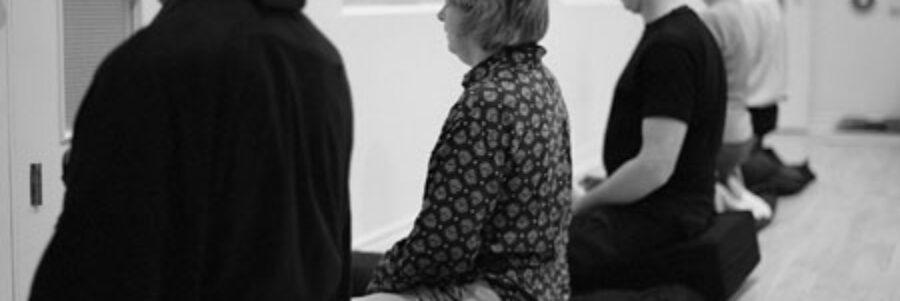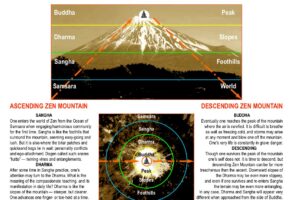
This has been a busy month, what with a week-long retreat in Halifax followed by a weekend at our newly established Three Streams mountain retreat center. I had initially planned to write about Master Dogen’s Sansuigyo: Mountains and Waters Sutra, which was the subject matter of the dharma talks at both retreats. I will post that piece soon.
But an article on the front page of last Sunday’s New York Times (NYT) Sunday Review section, titled “You’re So Self-Controlling” caught my attention, with its question, “Is our sense of time, not our lack of willpower, the real issue?” Its subsequent discussion of our perception of time made me change my mind. I decided to address this troubling matter of making time for Zen, which may be of more immediate relevance to our members, as we mark the annual November celebration in memory of Matsuoka-roshi’s legacy.
…if you can let go of your body and mind with each breath as you practice zazen, you will find that you can feel, no matter how obliquely or faintly, this original nature shining effulgently. This is true even if you are sitting in zazen for the first time.
rev. dr. zengaku soyu matsuoka, roshi
We will return to the article in a bit, but first I would like to direct your attention to “Dhyanayana, Zen Ways,” the first chapter in O-Sensei’s collection of his later talks, Moku-Rai, the second of what will be a four-volume archive of his teaching, scheduled for completion in 2014. In it, he reinforces a message that he stated clearly elsewhere — that by far the largest group of Zen practitioners in the West, especially in the USA, are those who start practicing and then quit too soon. By too soon, he meant before the real benefits and effects of zazen could set in, and long before any long-term assimilation of the Zen life could transpire.
In this excellent and well-researched survey of the various approaches to Zen, ways amongst the Way, comparing the seemingly sudden approach of the Rinzai sect with the more measured and gradual approach of Soto Zen, he makes the point that in one important sense, Zen takes no time at all:
…if you can let go of your body and mind with each breath as you practice zazen, you will find that you can feel, no matter how obliquely or faintly, this original nature shining effulgently. This is true even if you are sitting in zazen for the first time.
But in another sense, the longer term is where we should focus our attention, rather than build expectations of quick rewards to unreasonable heights:
With this right attitude toward your practice (that Dogen was so kind to point out), in the course of twenty to forty years of constant, concentrated, diligent and intense zazen, the little self will become completely dissolved well within your lifetime.
There’s a real buzz-killer. When people would naively ask Sensei how long it might take to be enlightened, he would get a mischievous smile and a sparkle in his eye, and say, “For you – ten years!” Or twenty, thirty years, depending. He was brutally honest, but also meant to assure anyone that the wait would be worth it:
Mokushozen, moku-rai, Zen of silent illumination: each day you will feel the gradual increase in radiant self-nature. From the point of view of original enlightenment, there is no change, during all those days, years and decades of long practice. The change, rather, is that you are touching and listening more to the primal ground that has always been present in constant quantity and quality described from an earthbound perspective.
This is touching on a central theme of the NYT article, that it may be more our perception of time, than the anticipated effect of delayed gratitude, that effects our decision-making, in this case concerning a spiritual practice and discipline. The subtlety of the effect of zazen renders it just outside the realm of direct perception, and so doubts arise as to whether any change is occurring or not. What we are tuning into in zazen is something real that is ever-present, yet tends to be overlooked in the daily pressure cooker that is life in the 21st Century.
Sensei goes on to finger the stubborn nature of our cultivated habits of thinking and living as the real culprit in necessitating such a protracted program of Zen practice:
From the point of view of living a happy life, however, it takes time to change bad habits, and that seems like gradual progress. If you bite your fingernails, how many years do you think it will take to stop — providing of course, that you are really serious? In Soto Zen, we each set about changing the fundamental bad habit of blind, limited and conditioned perception, so it will seem to take a very long time indeed. Dogen, more than any other Zen master before him, emphasized this approach of Soto Zen as being the only Zen approach compatible with our original self.
So this is Matsuoka-roshi’s way of differentiating Soto from Rinzai in terms of their suitability to the practice of all. He goes on to explain the popularity of Rinzai Zen in the Japan of Dogen’s day as being more connected to the social and survival needs of the ruling class, rather than in tune with buddha-nature as such [interjections mine]:
By the time that Dogen returned from China, “empty-handed” as he put it, Rinzai Zen had become established in Japan through Zen master Eisai and others. Rinzai was closely connected to the ruling class.
If you look for the root reason for Rinzai’s success in this era, I think it is that which I spoke of earlier. The upaya, or skillful means of teaching which the koan method was, accorded extremely well with the spirit of aggressive mastery that characterized Bushido [the code of the Samurai]. These men and women who were always near the power of the state could become involved in deadly intrigue or sudden war that might just as easily lead them to being murdered or forced to commit hara kiri [suicide] in the next moment, as it could lead them to be able to enjoy the sun setting over the iris near Lake Biwa. This uncertainty, politically and personally over life and death, provided the impetus for, and the appeal of, Rinzai Zen.
It is vintage Sensei to use such a poetic image to highlight the real-world issues faced by the ruling class during Dogen’s time, as well as setting the stage for recapping his major point:
Even though I just described Soto Zen as being more in harmony with the working of the original nature, I have no hesitation in recognizing that for these samurai, Rinzai was the best upaya. It was the very conjunction in that age of all that they were with all that the Rinzai masters offered.
In other words, it was a socially-determined path, rather than a personal choice. This, it seems to me, is the crux of the matter for Americans practicing Zen today. The disjunction between personal and social life, and the uncertainty that accompanies modern life, is at the root of most of our problems, including those associated with Zen practice. This consideration returns us to the NYT article.
The author, Maria Konnikova, quotes several clinical studies to demonstrate that daily decisions are made not just on the basis of an inability to postpone or delay gratification, but that such decisions are intimately connected with our perception of time. And the uncertainty of just how long it is going to take to accomplish a goal, or receive a reward, is a major component in the decision to stick it out, or cut and run. Cutting losses, not wasting additional time if it seems that we can have no idea how long something is going to take, seems imminently sensible on its face. But we do not usually think of the process this way, as she explains:
When we think of self-control, we don’t normally see it in these terms — a reasoned decision to wait or not. In fact, the ability to delay gratification has traditionally been seen in large part as an issue of willpower: Do you have what it takes to wait it out, to choose a later — and, presumably, better — reward over an immediate, though not quite as good one?
This is descriptive of the attitude that leads to “macho Zen” — the idea that we have to gut it out, through pain and deprivation, in order to penetrate to the essence. It is a variation on the familiar meme that the artist has to suffer, in order to be able to create Art. Suffering is innate; no need to exacerbate it.
Many of the choices we make in life are like this, and usually present themselves as settling for the immediate — more sure, if less desirable. The Buddha discovered the Middle Way between two extremes: self-gratification and self-mortification. Postponing gratification is a kind of purgatory between the two. In such a state, the time invested becomes a primary determinative factor, ultimately testing our resolve, which reveals the dynamic of practicing Zen:
When we set a self-control goal for ourselves, we often have specific time frames in mind: I’ll lose a pound a week; a month from now, I’ll no longer get cravings for that cigarette; the bus or train will come in 10 minutes (and I’ve committed to taking public transportation as part of lessening my carbon footprint, thank you very much).
Many who seek out Zen have a similar frame of mind. Not only that their practice and lifestyle is consonant with such positive values associated with health of the individual as well as the commonweal, but that they will become more calm, more able to deal with stress at home and the office, as well as on the commute. Then, as Sensei says, when the serenity and peace of mind do not materialize as soon as expected, particularly in the insanity of the daily rush hour, they become disappointed in Zen, and quit:
But what happens if our initial estimate is off? The more time passes without the expected reward — it’s been 20 minutes and still nothing; I’ve been dieting for a week and a half now and still weigh the same — the more uncertain the end becomes. Will I ever get my reward? Ever lose weight? Ever get on that stupid train?
In this situation, giving up can be a natural — indeed, a rational — response to a time frame that wasn’t properly framed to begin with, according to a new series of studies…
So it is understandable that with a practice as complex as Zen meditation, with its effects taking place on so many levels – physical, mental, emotional, and, yes, social – it would prove difficult to continue in the face of little or no appreciable immediate, short-term gratification. Zen’s benefits can be seen only in retrospect, for example by remembering how crazy we were last year, or five or ten years ago. Or, as many testify, how quickly things go awry when we stop practicing for a while. And it all boils down to time — real time as opposed to conceptual or perceptual time. As these scientists and reporters are recognizing:
For those of us battling with goals we just can’t seem to reach, the knowledge that our perception of time — and not some inherent shortcoming — is partly to blame may enable us to be more successful in the future. Instead of beating ourselves up for a failure of willpower, we can instead focus on learning to better calibrate our time expectations from the get-go, setting realistic, concretely framed time goals that capture the reality of the task we’ve set for ourselves.
This is good advice for those embarking upon the great experiment that is Zen. If we can accept that time as we know it is not real time, we may be able to finally enter into real time. And that if we are to give Zen a chance, we have to suspend judgment about its effects — particularly the amount of time it will take for them to come to maturity. We will leave it to the reader to define success in Zen.
But this idea should be a source of relief for those who take their Zen practice seriously. It means that we do not have to expect any immediate results of any great consequence. We can relax and take the long view, secure in the assurance of our Zen Ancestors that if we only persevere — without attachment to any outcome — the profound and transformative effect of zazen will manifest in our lives without any special effort of willpower to control it.









